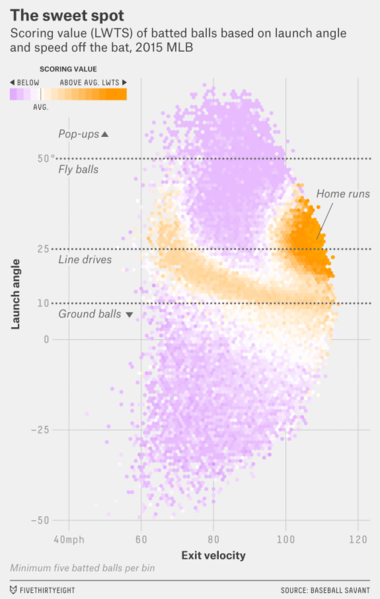I hesitate to post on hitting threads. Hitting threads can be so, well I can't even find the words to describe it. I guess it goes back to all the threads on rotational, linear etc etc.
Some kids are simply born with the ability to time it up. Some are simply born with the ability to barrel the baseball consistently. Some have a natural swing path and many do not. It is a lot like throwing motions. Some are born with a natural ability to throw. It just flows. No one had to teach them it's natural to them. Some have to be taught and trained to do what comes natural to others.
I believe the best swing path is the one that gets you in the zone the quickest, allows you to stay in the zone the longest, gets there with a slight uppercut, and is on time. BP for hitters is easy. It's quite honestly an ability to reproduce that sweet swing over and over. Almost every pitch is barreled up hit with authority. The vast majority of the balls hit are either line drives or deep fly balls. Ground balls are smoked but rare.
The ground ball has been taught for years at the HS level. Your dealing with a wide variety of skill levels. Your dumbing down is what your doing. You don't take the time to teach individuals you cookie cutter approach it. The theory was created in order to give your team a better opportunity to win at the expense of the actual development of your players. This is how it was explained to me when I first started coaching at the HS level.
Fly Ball - It takes one player making one play to record an out. Most players are incapable of leaving the yard. Fly balls result in outs the vast majority of the time.
Ground Balls - It has to be hit where a fielder can actually get to it. He has to field it cleanly. He has to make an accurate throw. It has to get there in time. Someone has to catch it - to record an out.
So the more ground balls we hit the better opportunity we have to win the game.
So what happens is coaches are teaching hitters to swing down on the ball in order to create more ground balls. Probably giving some hitters a better opportunity to reach base. Probably winning more games. And definitely hindering the development of hitters greatly.
I believe as a coach your job is to develop your players to the best of your ability. Ultimately giving your team the best opportunity to have success at the same time giving your players the best opportunity to have success. I believe you should coach up to the highest level not down to the lowest. I believe your goal should be that every player play at the highest level they can achieve. In other words when your coaching Pre HS players you should be preparing them for HS baseball. When your coaching HS players you should be preparing them for college baseball. Etc etc.
I don't believe you do that by sacrificing their development as players for the sake of winning a game today. The fact is you will win more games today by preparing them for tomorrow.
Hitting for me is about mashing the baseball. Hitting it as far and as hard as you are physically capable of. Developing a swing path that you can repeat with ease over and over again and take to the game with confidence. I never liked BP in the cage. I used the cage for drills. I believe in hitting live on field. I want the player to get that feedback now. I want that feedback now. When players understand launch angle and get that feedback they can see, they learn how to make the needed adjustments. They at the least can relate to what you are trying to teach them.
I understand some kids are not strong enough entering HS to have the success with this approach that they are used to at the younger levels. That bomb at 13 14u is now a routine fly ball on the HS field. Now that is a fact for many. That 300' fence is now 375' 400'. But as they get stronger it all works out. Do you dumb them down to get on base and when they get stronger change their swing to accommodate the new found strength? No of course not. We teach mechanics to produce the absolute most velo we can get and continue to push the limits on creating more and more velo. You will never throw it too hard. Then why don't we do the same with hitting? Do we say "Don't try and throw hard. Don't work for more velo. Just fool them. Then why do we tell hitters to simply settle for GB's because it will help us win?
Of course just because you work to create a swing that produces lift and power doesn't mean you won't still produce some GB's. It's just not the goal. But maybe those GB's will be freaking worm burners you just missed? I don't have all the answers but I believe hitting should be fun and it should be MAXED out in the same way VELO is maxed out. Get all you can and you never have enough.




